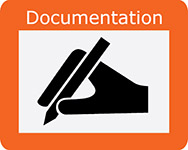Own the Phone with Spencer Peller

Spencer Peller is the Co-Founder and CEO of YesTrak and Founder and CEO of MyDoctorCalls. He is also the author of the new book Own the Phone! Today’s training is all about your telephone! If you’re a business owner, you know how important your telephones really are. This training will help you understand every aspect of answering the phone. It’s also a great training for your staff, so make sure you send this link to them and tell them to watch it. Click the interview below to get started… For more information about YesTrak: Visit: www.YesTrak.com Call: (800) 620-5877 Send email to info@yestrak.com
Chiropractic Documentation Fast and Compliant Notes

Fast and Compliant Notes for Chiropractic Practices Documenting cases quickly while remaining compliant with both insurance and government regulations seems like an impossible task. Especially when you factor in the images, forms, tests and more that go into proper documentation. Fortunately, it’s now possible to compile all the information you need, quickly, from a single screen. Watch this webinar to find out how! Read the transcript: Reuven: Welcome to Genesis’s webinar on compliance. Today we’re gonna talk about the travel card. My name is Reuven Lirov. I am currently the Chief Growth Officer and I work with over 500 practices and more than 1,600 practice staff across multiple specialties. My team posts more than $10 million in monthly insurance payments, focusing on finding ways to accelerate practice cash flow, improve compliance, and foster office staff teamwork. In the past 5 years, our clients have seen an average revenue growth of over 186%, patient visit growth of over 141%, and an 86% increase in patient visit compliance. So let’s get right down to it. Really what we wanna talk about today is the need to be able to complete and review documentation as quickly as possible. And this is a need that comes up all the time. Anytime we talk to some who is struggling with their current solution opening a new office, expanding their office and needs something that’s more scalable, the biggest problem they have is that they wanna spend more time with their patients, less time in a solution, and they wanna still stay 100% compliant with state insurance and federal requirements. So it’s a really difficult problem to solve, and each issue plays into the other. So this problem is really critically important because documentation obviously is a critical component to practice success. You know, one thing that happened to me a lot was as an EMT was when I was in college, we would constantly have to be reminded of the need for very, very clear documentation, especially when you’re dealing with outside patients where, you know, if you didn’t write it down, it didn’t happen. And that was the go-to phrase that we would give to new recruits, “If you if you didn’t write it down, it didn’t happen.” And even though you’re trying to do that, the goal is to have notes that take seconds. You wanna be able to spend most of your time interacting with your patient and a fraction of that time documenting so that all of your patient interactions are maximized. Because at the end of the day, it’s all about making sure that that patient is getting better and that patient is getting so much better that they’re feeling compelled to bring in their family, and their friends, and anyone else that they know that may be suffering or need your help. So even though we understand what this problem is, we understand why it’s important, there are still so many practices out there that are struggling, and so it’s obviously a difficult problem. And so compliant notes really struggle to be fast notes. That’s not an easy problem to solve, and if it didn’t matter how specific the notes were to anyone but yourself, you would do what a lot of providers do today, which if you ask them, you know, they’ll admit to it, they won’t be happy about it, but the reality is a lot of them scribble notes down. And if that’s you, don’t worry about it, we’re here to help. You know, a lotta the time I hear things like, you know, scribbling things down, stuffing them into a paper file, and spending the majority of your time with your patient, which is what you should be doing, really. But you really don’t have a choice because, you know, you need to have a compliant note and you need to have a referring patient. And so obviously this won’t work. You know, you gotta be able to finish your notes quickly, but you still have to stay compliant. And, you know, if that’s not something that you’ve struggled with recently, statistically speaking, every practice, if it’s in business more than five years will eventually get audited by a state board or a regulatory agency like an insurance company, something like that. So get ready for that. And it’s…you know, if you haven’t done it yet, it’s time to get that house in order. So documentation often spans more than just soap notes. So when you think about documentation, we have to think about the entire patient’s care. And so the soap note is one piece of that, your subjective objective ADL assessment and plan, but there’s also images, there’s forms like intake forms, and verification of benefits, and medicare forms, lengthy tests, and so much more, especially if you’re dealing with a multi-specialty practice where you’re bringing in, you know, different specialties that compliment your own. So the question is really, what’s our approach? You know, the reason why we’re so successful in working with our practices is because we look at the practice the way you look at your patients. Instead of trying to solve an individual symptom, which is I spend too long documenting, we really wanna understand the root cause of the problem. So we wanna look at this really in five areas. We wanna talk about the patient’s travel card, we wanna talk about that patient’s history, wanna talk about billing, wanna talk about personal notes, we wanna talk about documentation. A lotta the time I hear things like, “Well why do I need to talk about billing if we’re talking about documentation? Why do I need to talk about the patient’s history or even scheduling when I’m talking about documentation?” And so when you try to take into account the issues surrounding documentation and trying to get patients better, if you’re not able to connect your billing the rest of your documentation to your soap note, including
The Secret to Better Practice Management Decisions

Learn how to use metrics for better decision making! Metrics are what you need. When it comes to managing your practice, it’s often difficult to make informed, timely decisions without data. That’s because practice owners are frequently unsure of which performance indicators they should measure, or even how to get started. Or, they ignore the data and operate on instinct. Analytics, however, take the guesswork out of practice management, while simplifying the data so it can be easily understood. These tools provide increased efficiency and effectiveness, for improved decision-making ability.
Revenue | Getting Started with Billing Software

Prepare for Launch! Getting Started with Billing Software. Dr. Wilson and Luisa make final preparations to dive into their Genesis adventure together As Ben sipped his coffee and checked his email, Luisa peeked her head into the doorway and asked, “Are you ready, Dr. Wilson?” Ben smiled and said, “I’m not sure, but let’s go ahead anyway.” Luisa dialed the phone number for Charlie, their Genesis coach. After a couple of rings, Charlie picked up on the other end. “Good morning,” he said cheerfully. “So today’s the big day!” “Hello Charlie,” laughed Ben. “It sure is. And I think we’re finally ready.” “Then let’s get started – we’re going to talk about the features of Genesis that will be most useful for your practice and offer that final bit of reassurance that you’re doing the right thing,” Charlie said. “They don’t call me the King of Practice Success Coaching for nothing!” “OK Charlie, we’re ready,” said Ben. “Let’s go through this one last time.” “Let’s start with the ‘why’ of the Billing Stats Report, and relate it to some of the challenges you may be experiencing in your practice,” Charlie said. “You’re doing pretty well financially but have you ever experienced any sudden drop-offs in revenue that you couldn’t easily explain?” Luisa and Ben looked at each other and could remember several occasions when that was the case. Just a few months ago they had seen a significant and disturbing reduction in revenue and it had taken weeks of going through billing records, manually, to learn that Pam had been writing the wrong billing code on a number of Ben’s patient files. Every single one of those claims was delayed or denied outright. They were still trying to get some of the accounts sorted out. “Yes, we’ve found it very difficult to troubleshoot issues with reimbursements,” admitted Luisa. “And it’s not always the insurance companies’ fault – getting even one number wrong in the coding or forgetting to include important documentation can really impact our success in collecting what we’re owed.” “Exactly, it’s about achieving billing compliance AND payer compliance,” Charlie said. “But it’s important to recognize that the insurance companies are not going to give you a step-by-step reporting on the progress of your claims – it’s better for them if you’re not able to stay on top of the process.” “I’m sure I’ve mentioned to you before that the chance of getting paid on a claim decreases by 1 percent with each passing day,” he continued. “That 1 percent adds up really quickly when you’re talking about an entire practice’s worth of patients and numerous claims.” Ben and Luisa both had to swallow hard at the thought of the tens of thousands of dollars they had lost due to reimbursement issues. “It really is amazing the detail you can get,” Charlie said. “The reports are customizable to your particular needs and will tell you where problems are – whether on your end or the insurance company. Perhaps there are two codes on a claim that don’t quite go together, or a clinician forgot to include some demographic information in the claim … or maybe an insurance company is consistently underpaying certain CPT codes, or pushing the boundaries of its accounts receivable window. You can’t fix problems until you know what they are!” “That’s true,” said Ben. “I definitely don’t envy Luisa – she’s been an incredible investigator when it comes to solving cash flow mysteries but the time she has needed to dedicate to these investigations has definitely taken crucial time away from other office management needs.” “If the roots of billing problems were easy to find, we’d be able to deal with them quickly and decisively,” said Luisa. “You know how I love to have a plan!” Ben nodded and smiled. “And it’s not just insurance companies,” Charlie said. “You can stay on top of private payers, as well, and make sure that your patients are on track with visits and billing.” “That would be really helpful,” said Luisa. “We’ve had several patients who were significantly behind and once we figured out where their accounts stood, it was a real financial hardship for them to try and catch up all at once.” “But it’s not all about reimbursements – what’s great about Genesis is that it provides you with a checklist for all of your performance indicators, such as unbilled visits, patient visits, no shows, unfinished claims, or any other success measures you’d like to track,” said Charlie. “Another great feature is the radar chart, which allows you to see certain areas within your practice where attention may be needed,” he continued. “You can set parameters, such as new patient numbers, so that you will know if you’re not meeting your goals. Once you’ve set the desired parameters for a number of performance indicators within your practice, then you won’t need to refer to the Billing Statistics Report – unless the radar indicates there is a problem with performance. Between the radar and the Billing Statistics Report, you are going to be firmly in control of your practice’s financial health and performance.” “This is incredible,” mused Ben. “Being able to focus on building this practice instead of worrying about when reimbursement checks are going to arrive? I really didn’t think it was possible.” “I know you’re still probably a little intimidated about getting started but let me offer this final testimonial: In the past three years, my clients have seen average revenue growth of over 186 percent, patient visit growth of over 141 percent, and an 86 percent increase in patient visit compliance,” Charlie said. “Your patients will have more buy-in with regard to their own health care, you will have less administrative work to slog through, you will collect more money and – best of all – you will be able to spend more time with your patients.” “Well, that’s what we’re all here for,” said Ben. “Let’s do this!” Is Genesis the solution Ben’s

